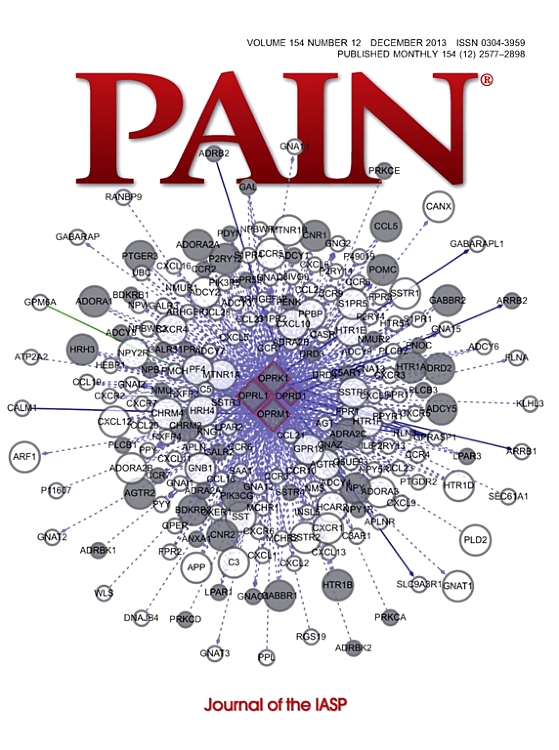STIM1在功能上与瞬时受体电位锚蛋白1偶联,参与伤害感受。
IF 5.9
1区 医学
Q1 ANESTHESIOLOGY
引用次数: 0
摘要
STIM1是一种钙传感器,可以感知内质网(ER)钙水平的变化,并对细胞外刺激做出反应。我们已经报道了STIM1在伤害感受器中表达。然而,其功能意义尚不清楚。在这里,我们发现STIM1在雄性和雌性小鼠感知寒冷、化学和有害机械刺激方面发挥重要作用。我们发现瞬时受体电位锚蛋白1 (TRPA1)的激活触发ER Ca2+释放,STIM1易位和存储操作Ca2+进入(SOCE)。免疫染色和western blot结果显示,TRPA1在内质网中表达。此外,初级感觉神经元中STIM1的缺乏减少了冷-、异硫氰酸丙烯酯(TRPA1激动剂)-和缓激肽诱导的Ca2+进入和伤害感受。此外,足底注射thapsigargin(一种ER Ca2+- atp酶抑制剂)会引起痛觉并增加疼痛超敏反应,这在STIM1条件敲除或L3/L4背根神经节敲除STIM1的小鼠中显著减弱。机制研究表明,stim1介导的SOCE增加了小至中等背根神经节神经元的神经元兴奋性,降低了钾通道kv4介导的向外电流,这种电流通过抑制丝裂原激活的蛋白激酶/细胞外受体激酶途径而被消除。我们的研究结果表明,STIM1作为痛觉的换能器,并揭示了STIM1和TRPA1ER之间的新联系。我们的研究也为trpa1介导的伤害感受提供了新的见解。本文章由计算机程序翻译,如有差异,请以英文原文为准。
STIM1 functionally couples to transient receptor potential ankyrin 1 contributing to nociception.
STIM1 is a calcium sensor that can sense calcium level changes in the endoplasmic reticulum (ER) and respond to extracellular stimuli. We have reported that STIM1 is expressed in nociceptors. However, its functional significance remains unclear. Here, we show that STIM1 plays an important role in sensing cold, chemical, and noxious mechanical stimuli in both male and female mice. We found that activation of transient receptor potential ankyrin 1 (TRPA1) triggers ER Ca2+ release, STIM1 translocation, and store-operated Ca2+ entry (SOCE). Immunostaining and western blot results reveal that TRPA1 is expressed in the ER. In addition, STIM1 deficiency in the primary sensory neurons reduces cold-, allyl isothiocyanate (TRPA1 agonist)-, and bradykinin-induced Ca2+ entry and nociception. Moreover, intraplantar injection of thapsigargin, an ER Ca2+-ATPase inhibitor, evokes nociception and increases pain hypersensitivity, which is significantly attenuated in STIM1 conditional knockout or L3/L4 dorsal root ganglia STIM1 knockdown mice. Mechanistic studies demonstrate that STIM1-mediated SOCE increases neuronal excitability and decreases potassium channel Kv4-mediated outward currents in small to medium-sized dorsal root ganglion neurons, which is abolished by inhibiting the mitogen-activated protein kinase/extracellular receptor kinase pathway. Our findings demonstrate that STIM1 acts as a transducer of nociception and uncover a novel link between STIM1 and TRPA1ER. Our study also provides new insights into TRPA1-mediated nociception.
求助全文
通过发布文献求助,成功后即可免费获取论文全文。
去求助
来源期刊

PAIN®
医学-临床神经学
CiteScore
12.50
自引率
8.10%
发文量
242
审稿时长
9 months
期刊介绍:
PAIN® is the official publication of the International Association for the Study of Pain and publishes original research on the nature,mechanisms and treatment of pain.PAIN® provides a forum for the dissemination of research in the basic and clinical sciences of multidisciplinary interest.
 求助内容:
求助内容: 应助结果提醒方式:
应助结果提醒方式:


